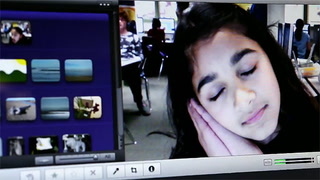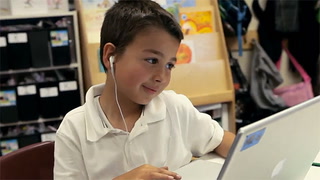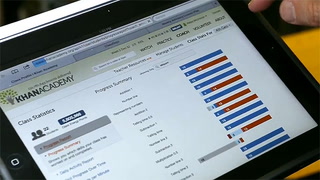[00:00:00]
Pronovost: Really trying to address giving every student what they need, and giving them that differentiated instruction is where the technology really comes in handy. Not only are they getting immediate feedback and they're able to move at their own pace, but them I'm also able to support the students who really need my support.
[TITLE - "TECH 2 LEARN"]
[00:00:31]
Pronovost: [TO STUDENTS] Today, what we are going to talk about is addition and subtraction. If she gives away 10 pencils, how many pencils will Theresa have left? I want you think about it. Is this addition or is this subtraction?
[00:00:45]
Pronovost: [TO CAMERA] Today, when we started in math, we sat down on the rug. We practiced identifying clue words and knowing if we need to add or subtract.
[00:00:54] [TO STUDENTS] How do we know we're doing addition?
Student: Because you said [sounds like:] "in on" (??) and that means altogether.
Pronovost: Okay.
[00:01:00]
Pronovost: [TO CAMERA] Once I felt that students really were getting back into the rhythm with addition and subtraction, that's when I moved them onto computers.
[00:01:09]
Pronovost: [TO STUDENTS] When you're at "Planet Turtle," you're doing your independent practice. You need to practice at least three games. And you'll need to get about 80% correct in order to move on to "Dream Box" or to the iPods.
[00:01:25] [TO CAMERA] "Planet Turtle" is a program that allows them to play games, and these games, they are being asked math questions. "Planet Turtle" gives them immediate feedback, whereas I would have to walk around the entire room to give them feedback. By them getting their immediate feedback through "Planet Turtle," I could grab some students who really needed some support, and work with them in a small group.
[00:01:47]
F: What is 10 minus 9? And I know the answer so I could ... you get a ... a point.
[00:01:56]
Pronovost: [TO CAMERA] For the students who were practicing on their own, "Planet Turtle" was a way to reinforce the addition and subtraction that we had practiced as a class. Once they've shown mastery in "Planet Turtle," they were able to move on to "Dream Box," and "Dream Box" gave them that individualized instruction at their own level, whereas "Planet Turtle" was only providing a basic practice for the entire class at the same level.
[00:02:19] I encourage my students to use all the tools that are available to them. One that we emphasize in this class is that using computers is not always the best tool. Using your hands may not always be the best tool. And so, when I have some students on "Planet Turtle," they might be solving the problem on their whiteboard, or they might be counting on their fingers, because that's the best strategy for them.
[00:02:43]
Pronovost: [TO STUDENTS] And our final answer would be ... 14.
[00:02:45] [TO CAMERA] My first two years that I was teaching, I didn't have any technology in my classroom. Not having access to those tools and knowing how valuable they could be is what kind of drove me to reach out to companies around, which led to receiving a few computers from Apple and then recently receiving a large grant from Facebook as well.
[00:03:05]
F: [PLAYING VIDEO GAME] I want to, like, practice a little bit more, for I could get, like, so much better here.
[00:03:11]
Pronovost: [TO CAMERA] The iPod Touches came to us through a SIG grant -- School Improvement Grant. "Dream Box" we started this year. We are just trying it out on a trial basis because most of the software we use in this classroom I either get through beta testing or through free trials.
[STUDENT CHEERING FOR RIGHT ANSWERS]
[00:03:33]
Pronovost: [TO CAMERA] The iPod Touch might be valuable at one time for students to practice a certain strategy or game, and then the MacBooks might support them in another way with their leveled reading or with differentiated math instruction.
[00:03:47]
Pronovost: [TO STUDENTS] What ... What number do we have in the tens place right here?
M: 4.
Pronovost: 4. What are we subtracting?
M: 1.
Pronovost: One group of 10. Four groups of 10 minus one group of 10. So, let's see ... 4 minus 1.
Many: 3.
Pronovost: Okay. 3.
[00:04:11]
Pronovost: [TO CAMERA] Every 6-8 weeks we take a benchmark exam so I can compare where my students were at the beginning of the year, umm, to where they are now, so I have seen some great improvement. I have data that shows that they're improving at a much greater rate than my students had in the past two years when I didn't have any of these applications.
[00:04:29]
Pronovost: [TO STUDENTS] We all start right here. What number is this right here?
Many: 1.
Pronovost: 1. What number is in the bottom right here?
Many: 3.
Pronovost: 3. Is there more on the top or there is more on the floor?
Many: More on the floor.
Pronovost: More on the floor.
Many: "Go next door."
[00:04:47]
Pronovost: [TO CAMERA] They are interacting in a much more fun way than, say, you know, answering questions and then just saying, "Yes, you passed; no, you didn't; move on to the next one." It's just a lot more engaging and exciting to them.
[00:04:59]
Pronovost: [TO STUDENTS] So now, I'm going to take away 3. 1, 2 ...
M: 3.
Pronovost: ... 3.
[00:05:05] [TO CAMERA] Because they're games, they are constantly being assessed. They need to pass this in order to move to the next level. So, while students feel like, "Oh, I'm working; I got to the next level," truly that means that they've mastered this concept; they're moving on to the next concept. It's just a new way of phrasing it.
[00:05:21]
F: 5 minus 2.
M: That's 3.
F: [sounds like:] Yeah (??).
[00:05:29]
Pronovost: [TO CAMERA] Students could be doing the same kind of practice on a worksheet, but if they're doing it on a worksheet they're going to get very bored easily. They're going to want to know what to do when they're done because there's no built-in levels to move on to, so I wouldn't have that time with the students who I really feel need my time and support.
[END OF VIDEO]















57 Comments
LUIS RILE Mar 26, 2024 4:44pm
Using technology gives Mr. Pronovost the freedom to differentiate instruction by providing access to personalized learning experiences, diverse resources, flexible delivery methods, and data-driven insights. This enables him to meet the unique needs, interests, and learning styles of each student, ultimately fostering greater engagement, motivation, and academic success.
Julie Davis May 18, 2023 2:45pm
I love that Mr. Pronovost was so resouceful in obtaining the computers and technology for his class.
Planet Turtle reinforced what he was teaching to the whole class and Dream Box allowed each students to work at their own pace and they get immediate on their answers. I liked that doing this allowed him the time to work with the students that were struggling.
Christopher Sch... Jan 16, 2023 10:56am
Immediate feedback in invaluable! It allows students to move at their own pace with confidence, prompts students to investigate what they did wrong, and promotes mathematical conversations.
Elaine Arquillano Feb 24, 2022 9:40pm
Differentiating in Math Using Computer Games
Lesson Objective: Use technology to practice addition and subtraction
Grades K-2 / Math / Technology
6 MIN
Math.2.OA.B.2
The greatest thing about technology is, it is state of the art, very relevant and up-to-date to the prevailing culture, enticing, fun and engaging for students. But I have seen and witnessed
times when the use of technology can be misused and abused in the classroom.
The application Mr Pronovost has chosen to use in the teaching of math, Planet Turtle and Dream Box, are both very applicable to his goals and the rationale of his objectives. I commend the fact that such technology, i.e., Planet Turtle provides immediate feedback. This, to me, is very important as the students are able to move on to their next level at their own pace. Without such built in features, as in worksheets, students would be left hanging, waiting for the teacher to find the time to check their work to give them direction or correction. The “magic of the moment”, as in a student raising his arms for the joy of getting his answer correct, would have been lost.
Planet Turtle is used as an assessment and placement tool, then kids move on to Dream Box which gives them individualized instruction. This is where the concept of “differentiated instruction “can be fully implemented. Mr. Pronovost’s choice of software to use in his class is so appropriate and suitable to his objective of “giving every student what they need and giving them differentiated instruction”. He’s right. That is where technology comes in, freeing him and giving him time to attend personally to those who really need a personalized approach to their learning. He’s one good educator---clear of his goals and motivated to find ways of achieving it.
By Elaine Arquillano
Matteo Tancredi Mar 1, 2021 4:13pm